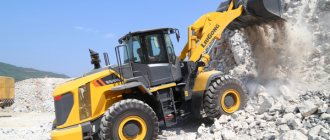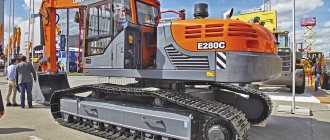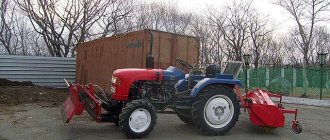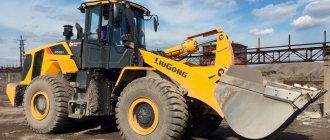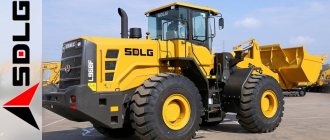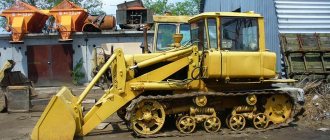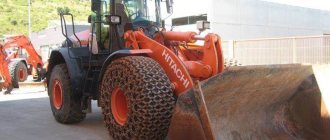Russian equipment for warehouse and construction companies successfully competes with foreign models, outperforming them in price and availability of spare parts. The domestic market offers machines from the largest factories specializing in the production of heavy construction equipment. They have proven themselves to be reliable mechanisms that operate smoothly in Russian production conditions.
JSC "Petersburg Tractor Plant" - front loader K-708PK7 "Kirovets"
The loader is designed for use in construction, quarries, warehouses, agriculture, land reclamation, and maintenance of roads of all types.
Weight: 21,000 kg. Load capacity: 7 tons. Engine: YaMZ-238 NDZ-6 with a power of 235 hp. Gearbox: hydromechanical Advance 4WG180 with electro-pneumatic control. Drive axles: Sub-engine and cargo axles, manufactured by PTZ, with self-locking differentials, planetary and final drives. Basic equipment: bucket 3100 mm wide, volume 4.1 m³. Unloading height - 3260 mm.
The two-seat, heated and air-conditioned cab has an integrated rollover safety cage (ROPS) and falling object protection system (FOPS). The main operating parameters are displayed on the electronic steering column panel. The working body is controlled using a joystick.
Optionally available:
- rock bucket,
- log grabber,
- forks for agricultural work,
- dynamic weighing systems,
- stabilization of the bucket when moving,
- control of rotation speed of the engine cooling system fan,
- Rear View Camera.
Narrow specialization
Some manufacturers of front loaders, instead of expanding functionality, take the path of creating highly specialized machines. Among them is JCB . The 434S AGRI loader, thanks to its increased power unit and axles with limited-slip differentials, copes well with silage harvesting. The 14-ton loader is equipped with a 6-cylinder Cummins engine with a displacement of 6.7 liters and a power of 230 hp. To increase cross-country ability and traction, a 6-speed automatic transmission was used, allowing 1st and 2nd gear to operate at speeds of up to 9 km/h for efficient compaction of silage. Also, the design of the gearbox allows you to change gears under load. Wide agricultural tires and a low center of gravity ensure machine stability when loading roughage. The “smart” cooling fan drive system changes the rotation speed depending on the temperature of the working fluids, maintaining it in the optimal range, which ensures uninterrupted operation with high efficiency. This allows the JCB 434S fork-equipped loader to compact the crops of two forage harvesters.
Fuel consumption of the JCB 434S is 11–12 l/hour. It takes 1–2 minutes to load manure into the back of a dump truck. A specially designed grain bucket with a capacity of up to 4 m3 allows you to load high-sided machines with a maximum dump height of up to 5 m. Data on operating parameters, machine load, fuel consumption and alarms, as well as maintenance warnings, are transmitted through the JCB LiveLink system and are accessible online.
The next generation Cat 950M jaw loader is designed for the forestry industry. It is equipped with a hydraulic suspension system for working equipment with two hydraulic accumulators. This system improves the vehicle's ride quality and provides a smooth ride on uneven terrain. The central display features a large text message screen, analogue gauges and LED warning lamps. Information messages about the machine's performance and activated functions, as well as diagnostic information, are displayed on the screen. Product Link allows you to access machine location, engine hours, fuel consumption, downtime and error codes through the VisionLink online application.
JSC "ChSDM" - front loader TL 155
Weight: 16,500 kg. Load capacity: 5 tons. Engine: MZ-536 with a power of 190 hp. Gearbox: ZF 4WG160 with manual control; A double gear pump is mounted on the output shaft, driving the hydraulic system of the working equipment, steering system and service brakes. Basic equipment: bucket 2500 mm wide (for driving on public roads), volume 3 m³. Unloading height - 3150 mm.
The spacious cabin with ROPS and FOPS protection is equipped with hydraulic supports, heater and air conditioning. A joystick with a transmission control function is used for operation. A separate multifunction display displays data on fuel consumption, engine speed, engine temperature, gearbox oil pressure, battery charge level, and operating hours. The image from the rear view camera is also displayed there. The main operating parameters are displayed on the electronic steering column panel.
Optionally available:
- self-locking differential for the rear axle,
- automatic lubrication system,
- bucket stabilization system,
- weighing system with memory,
- boom lift hydraulic cylinders with safety valves,
- additional circuit for attachments (adapter available for quick change),
- multi-channel video recorder with all-round view of the work site.
Japan, Sweden and... China
Modern high-performance Komatsu loaders are indispensable assistants when performing a variety of earthmoving and loading operations.
Unlike other manufacturers that locate their production in China or Brazil, Komatsu produces its machines exclusively in Japan, using its own components.
Komatsu front loader range is represented on the Russian market by eleven models from the medium to heavy class: from the WA150-6 model with an engine power of 100 hp and an operating weight of 7700 kg to the WA1200-6 with an engine power of 1790 hp and an operating weight 216,400 kg.
The machines are adapted to the harsh climatic conditions of Russia and can operate at temperatures from –40 to +40 °C.
The modern Komatsu front loader has important technical features. Among them are a hydrostatic transmission with electronic control and a speed range control system; large pillarless cab with built-in ROPS/FOPS structures; equipment condition monitoring system (EMMS); KOMTRAX Plus system, etc.
Serious attention is paid to safety. Working in quarries with large equipment requires special attention. For this, Komatsu engineers thought out a special design for the machines (using the example of the WA1200-6, the largest loader in its class): handrails and stairs for entering and descending from the cab; staircase lighting; wide, flat windshield for excellent visibility; emergency brakes, four points with emergency engine stop switch.
Hitachi front loaders are represented in Russia in a fairly wide range, including nine models: from ZW100 to ZW550. They are designed for use in urban environments, such as by utility companies, as well as in the mining industry. Operating weight varies from 7 to 46 tons, engine power - from 90 to 463 hp. The tipping load in the full rotation position depends on the model and varies in the range from 5 to 25 tons. The unloading height of the bucket is from 3.5 to 5 m.
The ZW-5A series of wheel loaders, introduced in Russia since 2015, implements several systems that help achieve energy-efficient operation, regardless of the operator’s experience. The Active Engine Control System adjusts engine speed depending on the work being performed. The computer receives data from various sensors located in all systems of the machine and sets the optimal speed of the power plant to achieve maximum performance. Depending on the tasks, the operator can use one of two operating modes: Power and ECO. Power mode forcibly increases engine speed and thereby increases machine performance. ECO mode is used to improve fuel economy during normal, light-duty operations. The ECO indicator indicates operation in fuel saving mode. The clutch disengagement function also proves to be very effective, when used, the force of the working equipment is significantly increased.
The most popular models among Russian customers are ZW310-5A, ZW370-G and ZW550. These machines operate mainly in difficult conditions: when mining crushed stone, gold, coal and other natural resources throughout Russia.
Volvo 28-tonne loader, with its traditional Volvo distinctive design, features several design changes. As a result, the car began to consume 15% less fuel than the previous G series model, and overall productivity increased by 10%. Next-generation load-sensing hydraulics improve work tool control and reduce cycle times. An automatic braking function has been added when changing direction and the ability to lock the torque converter to transfer torque from the engine to the gearbox without loss.
John Deere supplies the Russian market with seven models of high-performance front loaders: 524K-II, 544K-II, 624-II, 644K, 724K, 744K-II, 844K-III, as well as a basic level loader WL56. All loaders have three key features: good performance, reliable operation and low operating costs. John Deere front loaders are equipped with reliable diesel engines of our own production, John Deere PowerTech, with a high reserve of power and torque. All front loaders come standard with the five-speed PowerShift transmission, which provides smooth shifting under power and features ShuttleShift, which allows you to change direction without using the brake or clutch pedal. The wheel slip control function (for older models) eliminates wheel slipping when scooping material, which reduces fuel consumption and extends tire life. All machines have a function for returning the bucket to the loading position, as well as limiting the lifting height, which is important when working in hangars or under power lines. Daily maintenance is quick and easy because all components requiring daily maintenance are grouped on the left side of the machine and are accessible from ground level. The unique Quad-Cool cooling system provides easy access to the radiators from both sides, and the hydraulic fan with reverse function saves cleaning time when working on dusty sites. It's also worth noting that when equipped with the optional Ride Control System, the boom lift cylinders absorb bucket sway and allow the machine to move over uneven surfaces without spilling material.
XCMG products remain one of the most popular in Russia . The most popular machines on the market include the ZL30FV and ZL50GV loaders. Model ZL30FV 3 t capacity with Yuchai YC6B 92 kW engine provides unloading at a height of 2770 mm with a regular boom and 3260 mm with an extended one. The four-speed powershift transmission, drive axles and cab are manufactured at XCMG Group factories. The ZL50GV loader with a capacity of 5 tons belongs to the latest generation of ZL50G machines, which have been produced for more than 10 years.
Among the features of this modification, we can note the use of an axial piston pump with a variable displacement for precise adjustment of pressure and flow in the working and steering hydraulic systems in accordance with specific operating conditions. Automatic Power Distribution (APD) saves up to 15% fuel. Thanks to their particularly robust design, ZL50G loaders can withstand significant overloads. At the bauma CTT 2019 exhibition, at the stand of the Russian representative office of XCMG, the LW550RU loader with a capacity of 5 tons was shown, which was created on the basis of the LW500FN adjusted for Russian operating conditions.
Rybinsky - loader DM-34 "Volzhanin"
Widely used in public utilities, for road maintenance, and in warehouses.
Weight: 10,500 kg. Load capacity: 3400 kg. Engine: D-260.2 Minsk Motor Plant with a power of 123 hp. Gearbox: two modes of operation, a torque converter with increased output torque and two separate hydraulic pumps for the steering and working parts (the basis for the high maneuverability of the machine without loss of performance). Basic equipment: Axles with open differential. Unloading height - 2904 mm.
Optionally available:
- air conditioner,
- joystick for control,
- three-section hydraulic distributor,
- additional hydraulic line for attachments.
The working equipment is controlled using levers. Simultaneous lifting of the bucket and turning of the machine while driving occurs smoothly, without delay. An adapter for quickly changing equipment allows you to expand the functionality of the loader by using a jaw grip, forks, a brush with a hopper, and a bulldozer blade. A convenient, comfortable cabin of our own production with ROPS and FOPS protection is equipped with a heater.
Trends in the Russian market of forklifts and warehouse equipment
Now let’s look at the trends of the Russian market by class and present it in the form of a graph:
- Over 10 years, electric forklifts fell in number from 3,786 to 2,687 units, or by 25%.
- Reach trucks are the most stable warehouse equipment - 2,500 of them remain.
- Stackers and electric trolleys, as representatives of small warehouse equipment, grew by 70% from 6,000 units to almost 11,000 units.
- Forklifts fell by 2 times or 50% from 12,000 units to 6,000 units.
Recommendations from specialists for operating tracked undercarriages
Experts recommend avoiding counter-rotating tracks unless absolutely necessary. Turning in place causes accelerated wear and increases the likelihood of machine tracks failing.
Constant work on a slope with a roll and load in one direction contributes to wear on the track guide wheels, road wheels and track lugs. Operators should change direction when working on slopes whenever possible. Turns should be performed on level ground whenever possible.
Looking to the future
It is probably difficult to imagine now what a front loader will be like in 10–15 years, but we can say for sure that the direction of development will be set by rapidly developing digital technologies. Some manufacturers today are not only predicting the future, but are also trying to create now what awaits us ahead.
Case designers presented their version of a prototype forklift of the future with a futuristic design and an unusual operator interface. Moreover, development with a 230 hp engine. is already at the prototype testing stage. Biomethane obtained from processing household waste is used as fuel. The amount of harmful emissions was reduced by more than 90% compared to a diesel engine. In addition, a methane-powered car is much quieter. For security reasons, the operator must undergo facial recognition identification to enter the cab and start the machine. All buttons and switches have been replaced with large, intuitive screens that display text messages, a job site map, and CCTV images.
Voice control is used to control the media player, climate control system and communication with the work site. Special airless tires have been developed for the loader. When using conventional tires, the pressure can be changed from the operator's cabin. The safety system automatically stops the forklift at the work site when approaching personnel. The loader demonstrates a fast work cycle, maneuverability and stability.
Volvo CE, in turn, is testing autonomous fleet management technology using 5G mobile networks. The remote-controlled machines are expected to find use in the steel and energy industries, where moving materials could pose the risk of explosions or the release of toxic gases.
So, despite the fact that more and more standard and additional functions are being added to the design of modern front loaders, the operation of the machine as a whole is simplified. An example is the use of hydraulic valves with electrohydraulic control. The operator receives a number of benefits when operating this loader, including bucket return from the dump position to the pick-up position, a smooth stop at the end of the hydraulic cylinder rod stroke, and customizable response parameters. As a result, both experienced and novice operators have the opportunity to achieve higher performance on the job.

